Verizon and AST SpaceMobile finalize 2026 direct-to-cell launch
Verizon and AST SpaceMobile have advanced their partnership into a definitive commercial agreement to deliver space-based cellular coverage in the United States starting in 2026.
Key deal details and launch scope
The agreement enables Verizon subscribers to connect “when needed” to AST SpaceMobile’s low Earth orbit (LEO) satellites using standard, unmodified phones. AST says service will focus on coverage gaps across the continental U.S., and will extend Verizon’s premium 850 MHz low-band spectrum into remote areas. The companies had outlined a broader collaboration last year; this is the shift from financing and pilots to a commercial launch path. AST highlights successful space tests as proof points and positions the network for both commercial and government use.
Why Verizon’s timing matters for coverage and resiliency
Coverage parity and resiliency are back on the competitive agenda. Direct-to-device fills rural dead zones, boosts disaster recovery, and creates a differentiator without the cost and time of dense terrestrial buildouts. For Verizon, this is a way to protect high-end brand positioning and enterprise accounts with a “coverage assurance” layer. It also pressures rivals to firm up their own non-terrestrial network (NTN) roadmaps.
Market reaction and AST SpaceMobile stock impact
AST SpaceMobile’s stock surged further on the news after a strong run in 2025. Investors read the deal as validation of AST’s model and a clearer line of sight to revenue. Verizon shares were largely unchanged. Terms of the agreement were not disclosed.
Strategic context: the direct-to-device race reshapes telecom
Satellite-to-cell has moved from concept to commercial timelines, reshaping carrier strategy, spectrum policy, and device roadmaps.
Partnership landscape and competitive positioning
AST SpaceMobile has now locked in marquee carriers across regions, including earlier agreements with AT&T and Vodafone. This complements existing industry moves, such as U.S. carrier partnerships with other LEO providers and device OEMs enabling satellite messaging. The pattern is clear: operators are using alliances to hedge coverage, brand, and innovation risk while standards mature.
3GPP NTN standards, low-band spectrum, and core integration
3GPP Release 17 NTN provides the framework for satellite access using conventional devices, but implementation choices matter. Verizon’s use of 850 MHz highlights the importance of low-band spectrum for link budgets and device compatibility. Integration into the mobile core, policy control, emergency services, and lawful intercept must be engineered to carrier-grade norms. Interference coordination, power control, and mobility management between terrestrial cells and satellite beams are non-trivial and will determine quality of experience.
Enterprise, public safety, consumer, and IoT use cases
Enterprises in energy, utilities, transportation, logistics, maritime, and agriculture need continuous connectivity for workers and assets beyond fiber and macro coverage. Public safety and government users require resilient communications during disasters and outages. Consumer plans can package this as an add-on for hikers, travelers, and rural households. Over time, IoT devices with compatible radios could leverage intermittent satellite links for telemetry where terrestrial is impractical.
Execution risks and economics of direct-to-device
The path to scaled, profitable direct-to-cell service depends on capacity, regulatory approvals, device behavior, and clear monetization.
Capacity limits, latency, and performance trade-offs
Direct-to-device over LEO is capacity-limited compared to terrestrial networks. Beam sizes, spectral efficiency, and power budgets constrain throughput and simultaneous sessions. Expect initial offerings to prioritize basic voice, messaging, and low-rate data, with best-effort policies during congestion. Latency will be higher than terrestrial, though still well below geostationary systems. Service transparency and realistic SLAs will be critical for enterprise adoption.
Regulatory hurdles and spectrum coordination
Satellite use of terrestrial licensed spectrum raises coordination and interference questions across borders and bands. U.S. market entry hinges on continued progress with regulators on satellite-using-terrestrial-spectrum frameworks and safeguards for incumbents. International roaming will add further complexity as operators negotiate rights and handset behavior across jurisdictions.
Pricing, revenue share, and valuation gap
AST SpaceMobile’s current financials and its market value show a wide gap that only execution can close. The company reported minimal trailing revenue, yet carries a multibillion-dollar market capitalization, supported by aggressive growth expectations cited by analysts for 2027–2028. Forward price-to-sales multiples implied by those estimates are rich versus traditional telecom names and even many frontier-tech peers. Street targets tracked before this announcement suggested downside from recent trading levels, reinforcing how much must go right on launch cadence, network scale, and monetization. The Verizon deal improves revenue visibility, but investors still need disclosures on pricing, revenue share, and margin structure.
What carriers, enterprises, and investors should do next
Carriers, enterprises, and investors should translate the announcement into concrete plans, checkpoints, and risk controls.
Carrier and MVNO action plan
Define product constructs now: coverage assurance add-ons, emergency roaming, and enterprise continuity bundles. Align device whitelists and software updates to ensure handset compatibility and clear user experience during satellite fallback. Update RAN and core policies for NTN handover, billing, and priority treatment for public safety. Build a regulatory playbook for cross-border operations and interference mitigation. Plan targeted marketing for rural and outdoor segments.
Enterprise and public sector action plan
Map coverage gaps and incidents where satellite fallback changes outcomes. Pilot in high-need domains like field service, pipelines, forestry, ports, and disaster-prone regions. Negotiate SLAs that specify availability windows, throughput tiers, and priority handling. Revisit device procurement to ensure RF and software compatibility and consider accessories that improve link margins in challenging environments. Integrate satellite fallback into business continuity and emergency response drills.
Investor and analyst checklist
Track tangible milestones: satellite launch schedule, gateway build-out, device certification, regulatory approvals, and early-market pilots. Watch for pricing and revenue-sharing details with Verizon and other carrier partners, as well as disclosures on expected ARPU uplift, take rates, and cost per bit. Compare capacity growth versus demand to assess scalability and margin trajectory. Expect model revisions as commercial terms and timelines become clearer post-announcement.
Bottom line and outlook
The Verizon–AST SpaceMobile pact signals that direct-to-device is entering its commercial phase in the U.S., with meaningful strategic implications for coverage, resiliency, and competitive dynamics. The opportunity is real, but so are the execution and economic hurdles; disciplined pilots, transparent pricing, and standards-based integration will separate durable advantage from hype.








































